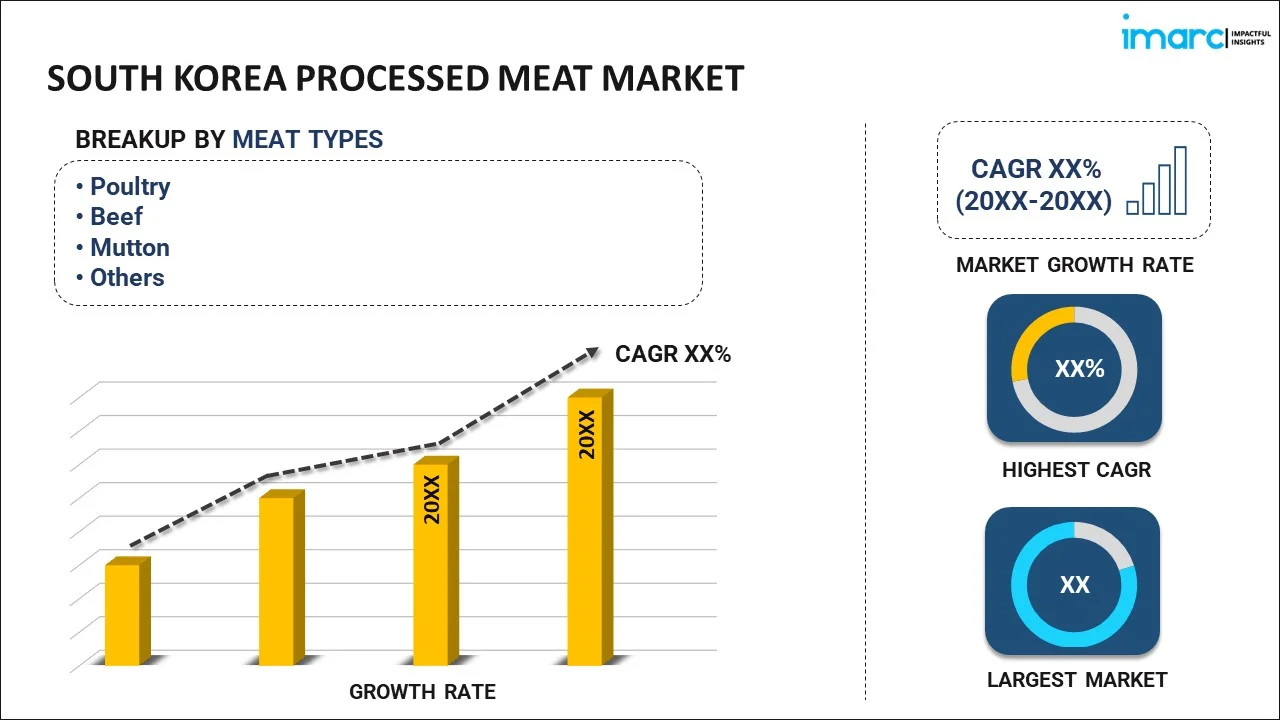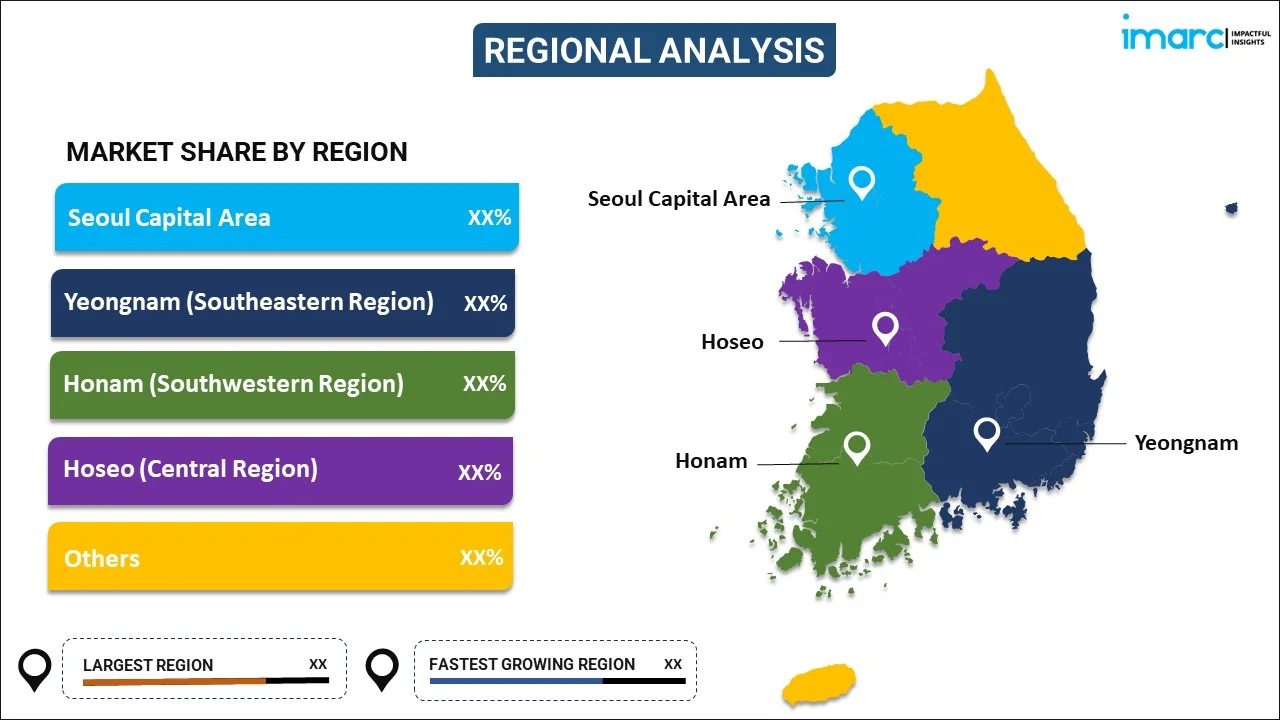
South Korea Processed Meat Market Report by Meat Type (Poultry, Beef, Mutton, Pork, and Others), Product Type (Fresh-Processed Meat, Raw Fermented Meat, Raw-Cooked Meat, Pre-Cooked Meat, Cured Meat, Dried Meat, and Others), Processing Type (Chilled, Frozen, Canned), Distribution (Institutional Sales (HoReCa), Retail Sales), and Region 2025-2033
Market Overview:
South Korea processed meat market size reached US$ 11.4 Billion in 2024. Looking forward, IMARC Group expects the market to reach US$ 17.1 Billion by 2033, exhibiting a growth rate (CAGR) of 4.60% during 2025-2033. The changing consumer lifestyles and the growing preference for ready-to-eat options are primarily driving the market growth across the country.
|
Report Attribute
|
Key Statistics
|
|---|---|
|
Base Year
|
2024 |
|
Forecast Years
|
2025-2033 |
|
Historical Years
|
2019-2024
|
| Market Size in 2024 | US$ 11.4 Billion |
| Market Forecast in 2033 | US$ 17.1 Billion |
| Market Growth Rate (2025-2033) | 4.60% |
Processed meat is a collective term encompassing meat products that undergo modification and enrichment through the addition of various substances. Commonly utilized additives include salt, sugar, oil, minerals, acidifiers, flavoring agents, preservatives, and other seasonings. The curing process is employed to enhance the taste and quality of the meat, prolong its shelf life, and improve overall flavor. Additionally, meat can undergo processing techniques such as cooking, smoking, and fermenting, which serve to minimize the risk of undesirable microorganism growth in the product at a later stage. These processed meat products serve as a substantial source of essential nutrients, including proteins, vitamins (such as selenium, choline, niacin, and riboflavin), and minerals. Various types of fresh meats, spanning red and white meat from swine, poultry, cattle, or sea animals, can be amalgamated and processed to produce an array of products like bacon, sausages, salami, hot dogs, beef jerky, canned meat, and meat-based snacks.
South Korea Processed Meat Market Trends:
The South Korea processed meat market has emerged as a dynamic and evolving segment within the country's food industry, reflecting changing consumer preferences and lifestyles. Common additives such as salt, sugar, oil, minerals, flavoring agents, and preservatives are utilized in the processing of meats like swine, poultry, cattle, and sea animals. Additionally, bacon, sausages, salami, hot dogs, beef jerky, canned meat, and meat-based snacks are among the diverse offerings that cater to the demand for convenient and flavorful food options. Besides this, the curing process, integral to processed meat production, not only enhances taste and quality but also extends shelf life, contributing to the market's popularity. Moreover, processed meat products in South Korea serve as rich sources of essential nutrients, including proteins, vitamins (such as selenium, choline, niacin, and riboflavin), and minerals. Despite considerations regarding cholesterol levels and preservative content, the convenience and enhanced flavors associated with processed meats continue to drive market growth. Apart from this, the emerging consumer trends and the introduction of innovative processed meat products align with the evolving food preferences in the country, which is expected to bolster the regional market in the coming years.
South Korea Processed Meat Market Segmentation:
IMARC Group provides an analysis of the key trends in each segment of the market, along with forecasts at the country level for 2025-2033. Our report has categorized the market based on meat type, product type, processing type, and distribution.
Meat Type Insights:

- Poultry
- Beef
- Mutton
- Pork
- Others
The report has provided a detailed breakup and analysis of the market based on the meat type. This includes poultry, beef, mutton, pork, and others.
Product Type Insights:
- Fresh-Processed Meat
- Raw Fermented Meat
- Raw-Cooked Meat
- Pre-Cooked Meat
- Cured Meat
- Dried Meat
- Others
A detailed breakup and analysis of the market based on the product type have also been provided in the report. This includes fresh-processed meat, raw fermented meat, raw-cooked meat, pre-cooked meat, cured meat, dried meat, and others.
Processing Type Insights:
- Chilled
- Frozen
- Canned
The report has provided a detailed breakup and analysis of the market based on the processing type. This includes chilled, frozen, and canned.
Distribution Insights:
- Institutional Sales (HoReCa)
- Retail Sales
- Supermarkets and Hypermarkets
- Grocery Stores
- Specialty Retailers
- Online Stores
- Others
A detailed breakup and analysis of the market based on the distribution have also been provided in the report. This includes institutional sales (HoReCa) and retail sales (supermarkets and hypermarkets, grocery stores, specialty retailers, online stores, and others).
Regional Insights:

- Seoul Capital Area
- Yeongnam (Southeastern Region)
- Honam (Southwestern Region)
- Hoseo (Central Region)
- Others
The report has also provided a comprehensive analysis of all the major regional markets, which include Seoul Capital Area, Yeongnam (Southeastern Region), Honam (Southwestern Region), Hoseo (Central Region), and Others.
Competitive Landscape:
The market research report has also provided a comprehensive analysis of the competitive landscape. Competitive analysis such as market structure, key player positioning, top winning strategies, competitive dashboard, and company evaluation quadrant has been covered in the report. Also, detailed profiles of all major companies have been provided.
South Korea Processed Meat Market Report Coverage:
| Report Features | Details |
|---|---|
| Base Year of the Analysis | 2024 |
| Historical Period | 2019-2024 |
| Forecast Period | 2025-2033 |
| Units | US$ Billion |
| Scope of the Report | Exploration of Historical Trends and Market Outlook, Industry Catalysts and Challenges, Segment-Wise Historical and Future Market Assessment:
|
| Meat Types Covered | Poultry, Beef, Mutton, Pork, Others |
| Product Types Covered | Fresh-Processed Meat, Raw Fermented Meat, Raw-Cooked Meat, Pre-Cooked Meat, Cured Meat, Dried Meat, Others |
| Processing Types Covered | Chilled, Frozen, Canned |
| Distributions Covered |
|
| Regions Covered | Seoul Capital Area, Yeongnam (Southeastern Region), Honam (Southwestern Region), Hoseo (Central Region), Others |
| Customization Scope | 10% Free Customization |
| Report Price and Purchase Option | Single User License: US$ 3699 Five User License: US$ 4699 Corporate License: US$ 5699 |
| Post-Sale Analyst Support | 10-12 Weeks |
| Delivery Format | PDF and Excel through Email (We can also provide the editable version of the report in PPT/Word format on special request) |
Key Questions Answered in This Report:
- How has the South Korea processed meat market performed so far and how will it perform in the coming years?
- What has been the impact of COVID-19 on the South Korea processed meat market?
- What is the breakup of the South Korea processed meat market on the basis of meat type?
- What is the breakup of the South Korea processed meat market on the basis of product type?
- What is the breakup of the South Korea processed meat market on the basis of processing type?
- What is the breakup of the South Korea processed meat market on the basis of distribution?
- What are the various stages in the value chain of the South Korea processed meat market?
- What are the key driving factors and challenges in the South Korea processed meat?
- What is the structure of the South Korea processed meat market and who are the key players?
- What is the degree of competition in the South Korea processed meat market?
Key Benefits for Stakeholders:
- IMARC’s industry report offers a comprehensive quantitative analysis of various market segments, historical and current market trends, market forecasts, and dynamics of the South Korea processed meat market from 2019-2033.
- The research report provides the latest information on the market drivers, challenges, and opportunities in the South Korea processed meat market.
- Porter's five forces analysis assist stakeholders in assessing the impact of new entrants, competitive rivalry, supplier power, buyer power, and the threat of substitution. It helps stakeholders to analyze the level of competition within the South Korea processed meat industry and its attractiveness.
- Competitive landscape allows stakeholders to understand their competitive environment and provides an insight into the current positions of key players in the market.
Need more help?
- Speak to our experienced analysts for insights on the current market scenarios.
- Include additional segments and countries to customize the report as per your requirement.
- Gain an unparalleled competitive advantage in your domain by understanding how to utilize the report and positively impacting your operations and revenue.
- For further assistance, please connect with our analysts.
 Inquire Before Buying
Inquire Before Buying
 Speak to an Analyst
Speak to an Analyst
 Request Brochure
Request Brochure
 Request Customization
Request Customization




.webp)




.webp)












